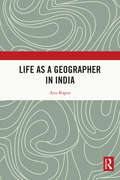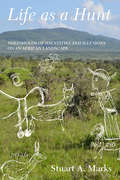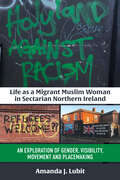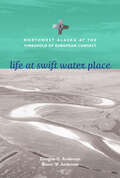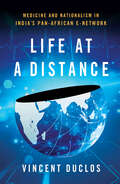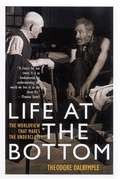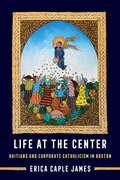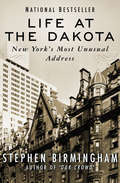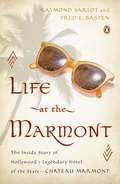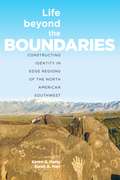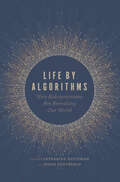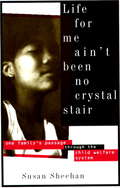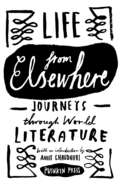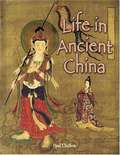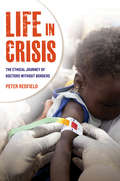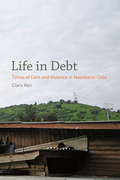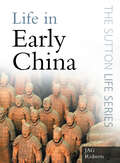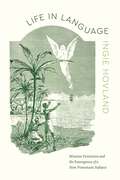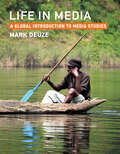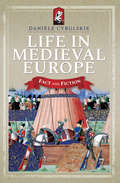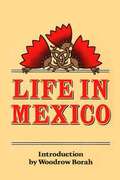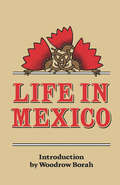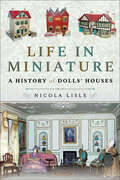- Table View
- List View
Life as a Geographer in India
by Anu KapurThis is the first book which provides an engaging and insightful narrative on the life of a geographer in India. The author introspects on her own experiences and engagements with the discipline and explores the life and works of twenty-four other geographers from India. The volume documents and acknowledges the commitment of geographers to life, teaching, and the subject of geography. Collectively these provide an insight into the growth and expansion of the discipline in the country. The book offers critical perspectives on the changing disciplinary practices within the field of geography by highlighting the major achievements and teaching methods of geographers. It highlights the diverse interests, themes, and problems in geography which these geographers pursued while also influencing the lives of other researchers and professionals. This book will be of immense interest to students, teachers, and researchers of geography and social anthropology and readers interested in the lives of these influential educators and academicians.
Life as a Hunt: Thresholds of Identities and Illusions on an African Landscape
by Stuart MarksThe "extensive wilderness" of Zambia's central Luangwa Valley is the homeland of the Valley Bisa whose cultural practices have enriched this environment for centuries. Beginning with the intrusions of warlords and later British colonials, successive generations have experienced the callousness and challenges of colonialism. Their homeland, a slender corridor surrounded by three national parks and an escarpment, is a microcosm of the political, economic and cultural battlefields surrounding most African protected areas today. The story of the Valley Bisa diverges from the myths that conservationists, administrators, and philanthropists, tell about Africa's environmental and wildlife crises.
Life as a Migrant Muslim Woman in Sectarian Northern Ireland: An Exploration of Gender, Visibility, Movement and Placemaking
by Amanda J. LubitThe lives of migrant Muslim women in divided, post-conflict Northern Ireland, both before and after the pandemic, are full of diverse stories and experiences of belonging. This book explores how women strive to belong and create a home despite pervasive hatred, sexism and racism. Under these circumstances, women employ various strategies to connect with people and places around them. Using personal stories, this book considers the relationships migrant Muslim women develop, the places they spend time and the activities they engage with. These stories are used to demonstrate the interconnectedness of gender, visibility, movement and placemaking as analytical concepts.
Life at Swift Water Place: Northwest Alaska at the Threshold of European Contact
by Anderson, Douglas D.; Anderson, Wanni W.This is a multidisciplinary study of the early contact period of Alaskan Native history that follows a major hunting and fishing Inupiaq group at a time of momentous change in their lifeways. The Amilgaqtau yaagmiut were the most powerful group in the Kobuk River area. But their status was forever transformed thanks to two major factors. They faced a food shortage prompted by the decline in caribou, one of their major foods. This was also the time when European and Asian trade items were first introduced into their traditional society. The first trade items to arrive, a decade ahead of the Europeans themselves, were glass beads and pieces of metal that the Inupiat expertly incorporated into their traditional implements. This book integrates ethnohistoric, bio-anthropological, archaeological, and oral historical analyses.
Life at a Distance: Medicine and Nationalism in India's Pan-African e-Network (Expertise: Cultures and Technologies of Knowledge)
by Vincent DuclosIn Life at a Distance, Vincent Duclos recounts the story of the Pan-African e-Network. Branded as "India's gift to the world," and as a "shining example of South-South cooperation," the Pan-African e-Network was an exceptionally ambitious project. Between 2009 and 2017 the network used satellite technology to connect hospitals across Africa with hospitals in India, providing medical education and delivering health care for patients at a distance. Duclos shows how, by accelerating the flow of expertise across continents, the network also created connected enclaves, at once commercial, infrastructural, and medical. Life at a Distance is the story of a project that, Duclos suggests, acted as a medium for speculation about the future—about medical markets, the nation, South-South relations, and a new world order beyond Western-centric scripts.
Life at the Bottom: The Worldview That Makes the Underclass
by Theodore DalrympleDR. DALRYMPLE Practiced medacine on four continents before taking up a practice in an inner city british slum. He discusses the causes, effects, and remedys of a poverty and hopelessness so pervasive that Third World Doctors go home seeing their own slum dwellers as rich by comparison.
Life at the Center: Haitians and Corporate Catholicism in Boston (Atelier: Ethnographic Inquiry in the Twenty-First Century #15)
by Erica Caple JamesA free ebook version of this title is available through Luminos, University of California Press's Open Access publishing program. Visit www.luminosoa.org to learn more. In Life at the Center, Erica Caple James traces how faith-based and secular institutions in Boston have helped Haitian refugees and immigrants attain economic independence, health, security, and citizenship in the United States. Using the concept of "corporate Catholicism," James documents several paradoxes of assistance arising among the Catholic Church, Catholic Charities, and the Haitian Multi-Service Center: how social assistance produces and reproduces structural inequalities between providers and recipients; how these inequities may deepen aid recipients’ dependence and lead to resistance to organized benevolence; how institutional financial deficits harmed clients and providers; and how the same modes of charity or philanthropy that previously caused harm can be redeployed to repair damage and rebuild "charitable brands." The culmination of more than a decade of advocacy and research on behalf of the Haitians in Boston, this groundbreaking work exposes how Catholic corporations have strengthened—but also eroded—Haitians’ civic power.
Life at the Dakota: New York's Most Unusual Address (New York State)
by Stephen BirminghamA riveting history of Manhattan's most eccentric and storied apartment building and the famous tenants who called it home When Singer sewing machine tycoon Edward Clark built a luxury apartment building on Manhattan's Upper West Side in the late 1800s, it was derisively dubbed "the Dakota" for being as far from the center of the downtown action as its namesake territory on the nation's western frontier. Despite its remote location, the quirky German Renaissance-style castle, with its intricate façade, peculiar interior design, and gargoyle guardians peering down on Central Park, was an immediate hit, particularly among the city's well-heeled intellectuals and artists. Over the next century it would become home to an eclectic cast of celebrity residents--including Boris Karloff, Lauren Bacall, Leonard Bernstein, singer Roberta Flack (the Dakota's first African-American resident), and John Lennon and Yoko Ono--who were charmed by its labyrinthine interior and secret passageways, its mysterious past, and its ghosts. Stephen Birmingham, author of the New York society classic "Our Crowd", has written an engrossing history of the first hundred years of one of the most storied residential addresses in Manhattan and the legendary lives lived within its walls.
Life at the Marmont: The Inside Story of Hollywood's Legendary Hotel of the Stars--Chateau Marmont
by Raymond Sarlot Fred E. BastenRaymond Sarlot bought the Chateau Marmont in 1975, but what was originally a business purchase became a love affair as he delved into the hotel's incredible history. From its perch overlooking the Sunset Strip, the glamorous Marmont reigned for decades as the spot for artists, writers, musicians, and actors of every stripe and remains a home-away-from-home for A-listers like Scarlett Johansson and Johnny Depp. Here, Sarlot and co-author Fred E. Basten share a wealth of scandalous and intriguing tales about them all, from the stars of Hollywood's Golden Era like Jean Harlow and Grace Kelly to idols of the sixties and seventies like Jim Morrison and John Belushi (who tragically died there in 1982). Whether your obsession is Hollywood history or celebrity gossip, Life at the Marmont has plenty of gripping, juicy stories to fascinate.
Life beyond the Boundaries: Constructing Identity in Edge Regions of the North American Southwest
by Karen G. Harry and Sarah A. HerrLife beyond the Boundaries explores identity formation on the edges of the ancient Southwest. Focusing on some of the more poorly understood regions, including the Jornada Mogollon, the Gallina, and the Pimería Alta, the authors use methods drawn from material culture science, anthropology, and history to investigate themes related to the construction of social identity along the perimeters of the American Southwest. Through an archaeological lens, the volume examines the social experiences of people who lived in edge regions. Through mobility and the development of extensive social networks, people living in these areas were introduced to the ideas and practices of other cultural groups. As their spatial distances from core areas increased, the degree to which they participated in the economic, social, political, and ritual practices of ancestral core areas increasingly varied. As a result, the social identities of people living in edge zones were often—though not always—fluid and situational. Drawing on an increase of available information and bringing new attention to understudied areas, the book will be of interest to scholars of Southwestern archaeology and other researchers interested in the archaeology of low-populated and decentralized regions and identity formation. Life beyond the Boundaries considers the various roles that edge regions played in local and regional trajectories of the prehistoric and protohistoric Southwest and how place influenced the development of social identity. Contributors: Lewis Borck, Dale S. Brenneman, Jeffery J. Clark, Severin Fowles, Patricia A. Gilman, Lauren E. Jelinek, Myles R. Miller, Barbara J. Mills, Matthew A. Peeples, Kellam Throgmorton, James T. Watson
Life by Algorithms: How Roboprocesses Are Remaking Our World
by Hugh Gusterson Catherine BestemanEssays on the downsides, dysfunctions, and dangers of automated decision-making: “An excellent survey of the algorithmically managed life.” —ChoiceThe phone systems that businesses use to screen calls. The link between student standardized test scores and public schools’ access to resources. The algorithms that regulate patient diagnoses and reimbursements to doctors. The impenetrable corporate bureaucracy that can drive customers in need of help up the wall—or drive them to suicide.The storage, sorting, and analysis of massive amounts of information have enabled the automation of decision-making at an unprecedented level. Meanwhile, computers have offered a model of cognition that increasingly shapes our approach to the world. The proliferation of “roboprocesses” is the result, as editors Catherine Besteman and Hugh Gusterson observe in this rich and wide-ranging volume, which features contributions from a distinguished cast of scholars in anthropology, communications, international studies, and political science.Though automatic processes are designed to be engines of rational systems, the stories in Life by Algorithms reveal how they can in fact produce absurd, inflexible, or even dangerous outcomes. Joining the call for “algorithmic transparency,” the contributors bring exceptional sensitivity to everyday sociality into their critique to better understand how the perils of modern technology affect finance, medicine, education, housing, the workplace, food production, public space, and emotions—not as separate problems but as linked manifestations of a deeper defect in the fundamental ordering of our society.“‘The Machine Stops,’ E. M. Forster’s 1909 science fiction story, tells the tale of a human society collapsing when the technology upon which it has become dependent fails. Think of [this] volume as ‘The Machine Starts,’ a collection of unsettling ethnographic accounts of the rise of algorithmic governance . . . A necessary and sobering call to arms.” —Stefan Helmreich, Massachusetts Institute of TechnologyContributors include: Catherine Besteman * Alex Blanchette * Robert W. Gehl * Hugh Gusterson * Catherine Lutz * Ann Lutz Fernandez * Joseph Masco * Sally Engle Merry * Keesha M. Middlemass * Noelle Stout * Susan J. Terrio
Life for Me Ain't Been No Crystal Stair
by Susan SheehanOn October 7, 1984, Crystal Taylor gave birth to a baby boy whom she named Daquan. Crystal was only fourteen. She was living with a boyfriend whom she was too young to marry, and her mother was addicted to heroin and cocaine. So under the law, Crystal and Daquan became wards of New York State's foster-care system--a sprawling, often slipshod web of boarding facilities, halfway houses, and paid surrogates that cares for almost 60,000 children. Life for Me Ain't Been No Crystal Stair is the story of what happened to Crystal and Daquan, as well as to Crystal's mother, who herself had grown up in various foster homes. It is a story of three generations of poverty, addiction, and abuse--and also a story of astonishing human resilience. And Susan Sheehan tells it with the same flawless observation, humor, and compassion that she brought to her classic Is There No Place on Earth for Me?From the Trade Paperback edition.
Life from Elsewhere: Journeys Through World Literature
by Various Amit ChaudhuriWriters in Translation, established in 2005 and supported by Bloomberg and Arts Council England, champions the best literature from around the world. To mark the programme's tenth anniversary, ten leading writers from around the world, many of whom have been supported in their work by English PEN, explore the themes of movement, freedom and narrative. Introduced by Amit Chaudhuri, the collection includes contributions from:Asmaa al Ghul - Palestine resident; originally from Bangladesh - Translated from the Arabic by Elisabeth JaquetteMahmoud Dowlatabadi - Iran - Translated from the Persian by Ahmad Karimi-HakkakAyelet Gundar-Goshen - Israel - Translated from the Israeli by Sondra SilverstonChan Koonchung - Born in Shanghai; raised in Hong KongHanna Krall - Poland - Translated from the Polish by Philip BoehmAndrey Kurkov - Russia - Translated from the Russian by Amanda Love DarraghAndrés Neuman - Born in Argentina; moved to Spain - Translated from the Spanish by Nick CaistorAlain Mabanckou - Born in Congo; raised in France; lives in America - Translated from the French by Helen StevensonElif Shafak - TurkeySamar Yazbek - Syria - Translated from the Arabic by Ruth Ahmedzai KempFrom the Trade Paperback edition.
Life in Ancient China (Peoples of the Ancient World)
by Paul ChallenA part of the "Peoples of the Ancient World" series, the book explores the land of dragons, its ancient empires and dynasties, its culture, beliefs and interesting facts.
Life in Crisis: The Ethical Journey of Doctors without Borders
by Peter RedfieldLife in Crisis tells the story of Médecins Sans Frontières (Doctors Without Borders or MSF) and its effort to "save lives" on a global scale. Begun in 1971 as a French alternative to the Red Cross, the MSF has grown into an international institution with a reputation for outspoken protest as well as technical efficiency. It has also expanded beyond emergency response, providing for a wider range of endeavors, including AIDS care. Yet its seemingly simple ethical goal proves deeply complex in practice. MSF continually faces the problem of defining its own limits. Its minimalist form of care recalls the promise of state welfare, but without political resolution or a sense of well-being beyond health and survival. Lacking utopian certainty, the group struggles when the moral clarity of crisis fades. Nevertheless, it continues to take action and innovate. Its organizational history illustrates both the logic and the tensions of casting humanitarian medicine into a leading role in international affairs.
Life in Debt
by Clara HanChile is widely known as the first experiment in neoliberalism in Latin America, carried out and made possible through state violence. Since the beginning of the transition in 1990, the state has pursued a national project of reconciliation construed as debts owed to the population. The state owed a "social debt" to the poor accrued through inequalities generated by economic liberalization, while society owed a "moral debt" to the victims of human rights violations. Life in Debt invites us into lives and world of a poor urban neighborhood in Santiago. Tracing relations and lives between 1999 and 2010, Clara Han explores how the moral and political subjects imagined and asserted by poverty and mental health policies and reparations for human rights violations are refracted through relational modes and their boundaries. Attending to intimate scenes and neighborhood life, Han reveals the force of relations in the making of selves in a world in which unstable work patterns, illness, and pervasive economic indebtedness are aspects of everyday life. Lucidly written, Life in Debt provides a unique meditation on both the past inhabiting actual life conditions but also on the difficulties of obligation and achievements of responsiveness.
Life in Early China
by J A G RobertsImagine that you found 'dragon bones' once used to predict the future, or wrote a poem in the Book of Songs, or uncovered the terracotta army guarding the tomb of the First Emperor. Read more about life in this fascinating culture in the pocket-sized introduction.
Life in Language: Mission Feminists and the Emergence of a New Protestant Subject (Class 200: New Studies in Religion)
by Ingie HovlandA new anthropology of Protestant feminism, anchored by the language experiments of one Lutheran community. The language of the Bible is a powerful lens through which many Protestants understand themselves and their world, and its prohibitions on women’s speech pose complicated challenges to women. Nevertheless, women frequently serve as vocal leaders in Protestant organizations, including the early twentieth-century Norwegian Mission Society. In Life in Language, Ingie Hovland offers a unique biography of Henny Dons, a leader of the society’s so-called mission feminists, that grapples with ways Protestant women crafted innovative, expansive self-understandings through Christian language. More than their male peers, the mission feminists turned to religious speech to express material, as well as heavenly, desires for paid work, voting rights, and more, and Hovland argues that these experiments in women speaking, reading, writing, and listening paved the way for a new way of being in the world.
Life in Media: A Global Introduction to Media Studies
by Mark DeuzeA new way to teach media studies that centers students&’ lived experiences and diverse perspectives from around the world.From the intimate to the mundane, most aspects of our lives—how we learn, love, work, and play—take place in media. Taking an expansive, global perspective, this introductory textbook covers what it means to live in, rather than with, media. Mark Deuze focuses on the lived experience—how people who use smartphones, the internet, and television sets make sense of their digital environment—to investigate the broader role of media in society and everyday life. Life in Media uses relatable examples and case studies from around the world to illustrate the foundational theories, concepts, and methods of media studies. The book is structured around six core themes: how media inform and inspire our daily activities; how we live our lives in the public eye; how we make distinctions between real and fake; how we seek and express love; how we use media to effect change; how we create media and shared narratives; and how we seek to create well-being within media. By deliberately including diverse voices and radically embracing the everyday and mundane aspects of media life, this book innovates ways to teach and talk about media.Highlights diverse international voices, images, and casesUses accessible examples from everyday life to contextualize theory Offers a comprehensive, student-centered introduction to media studiesExtensively annotated bibliography offers dynamic sources for further study, including readings and documentary films
Life in Medieval Europe: Fact and Fiction
by Danièle Cybulskie&“A lovely, witty treasure trove of a book, spilling over with historical gems . . . a very human history: sometimes weird, always wonderful.&” —Dan Jones, New York Times-bestselling author Have you ever found yourself watching a show or reading a novel and wondering what life was really like in the Middle Ages? What did people actually eat? Were they really filthy? And did they ever get to marry for love? In Life in Medieval Europe: Fact and Fiction, you&’ll find fast and fun answers to all your secret questions, from eating and drinking to sex and love. Find out whether people bathed, what they did when they got sick, and what actually happened to people accused of crimes. Learn about medieval table manners, tournaments, and toothpaste, and find out if people really did poop in the moat. &“To say that this book was fun to read would be an understatement. Cybulskie&’s knowledge radiates in every page of this short book . . . It was educational and entertaining all at the same time. Simply a wonderful resource for novice medievalists and writers of historical fiction and nonfiction alike.&” —Adventures of a Tudor Nerd &“All in all, this is an excellent book to put to bed many of the myths surrounding medieval existence that persist in the popular imagination. Easy to read and well worth the time to read it. I highly recommend this book if you want to get a mostly unbiased view of medieval life.&” —Battles and Book Reviews
Life in Mexico
by Frances Calderón de la BarcaThis book contains observations made during a two years' residence in Mexico, by Frances Calderón de la Barca, whose position there made her intimately acquainted with its society, and opened to her the best sources of information in regard to whatever could interest an enlightened foreigner. Also, it consists of letters written to the members of her family.
Life in Mexico
by Frances Calderón de la Barca Woodrow BorahThis is a pre-1923 historical reproduction that was curated for quality. Quality assurance was conducted on each of these books in an attempt to remove books with imperfections introduced by the digitization process. Though we have made best efforts - the books may have occasional errors that do not impede the reading experience. We believe this work is culturally important and have elected to bring the book back into print as part of our continuing commitment to the preservation of printed works worldwide.
Life in Miniature: A History of Dolls' Houses
by Nicola LisleA “comprehensive and enjoyable” guide to the centuries-long history of dolls’ houses and how they illuminate our past (Books Monthly).Dolls’ houses are tiny slices of social history that give us a fascinating glimpse into domestic life over the last three hundred years. Through text and photos, Nicola Lisle explores the origins and history of dolls’ houses and their furnishings, from the earliest known dolls’ house in sixteenth-century Bavaria to the present, and looks at how they reflect the architecture, fashions, social attitudes, innovations, and craftsmanship of their day. She discusses the changing role of dolls’ houses and highlights significant events and people to give historical context, as well as taking a look at some of the leading dolls’ house manufacturers such as Silber & Fleming and Lines Brothers Ltd (later Triang).Included are numerous examples of interesting dolls’ houses, the stories behind them, and where to see them—including famous models such as Queen Mary’s spectacular 1920s dolls’ house at Windsor Castle. There is also a chapter on model towns and villages, which became popular in the twentieth century and also give us a window on the past by replicating real places or capturing scenes typical of a bygone era, plus advice for dolls’ house collectors, a detailed directory of places to visit, a timeline of dolls’ house history, and recommended further reading.
